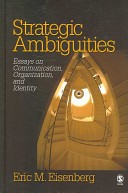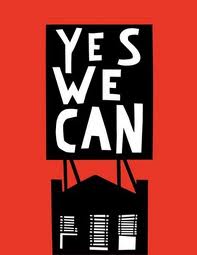In the mid-1980s, a young communications scholar, Eric Eisenberg, published what would become a highly influential paper, “Ambiguity as Strategy in Organizational Communications.” In it, he argued against the then prevailing view inside and outside of academia that clarity and openness were the primary criteria for assessing the effectiveness of communication. Instead, he suggested, ambiguity and even selective disclosure could be important elements in successful organizational communications.
Today, in a world in which the language of ambiguity, “plausible deniability” and selective disclosure has been used to mask ethical lapses, fiduciary irresponsibility and outright malfeasance, there is a growing hue and cry for openness and transparency.
In that context, we decided to take advantage of an opportunity to revisit Professor Eisenberg’s original insights with him, and look at whether they remained relevant in a very different world from the one in which they originated.
Dr. Eisenberg is now Professor of Communication and Dean of the College of Arts and Sciences at the University of South Florida, author of over 70 academic articles (many of which were collected in his book, “Strategic Ambiguities,”) and is working on the 7th edition of his highly-rated textbook, “Organizational Communication: Balancing Creativity and Constraint.”
Our discussion took place at The Communication Leadership Exchange Annual Conference in Atlanta, Georgia in early May 2012.
Strategic Leadership Communication:
The concept you’re most associated with is that of “strategic ambiguity.” Would you mind briefly describing what you mean when you suggest ambiguity can be “strategic” and a linchpin of effective communication?
Eric Eisenberg:
When I started in organizational communications in the 1970s and early 1980s, the research literature and even a lot of the training literature was really, really focused on clarity as the “sine qua non” of effective communication—that you’re a good communicator if you’re clear and if you’re understood.
What I realized at the time was that this was an incredibly simplistic notion of communication. Clarity is not a characteristic of messages. It’s about the fit between the person sending the message, the language in the message, and how the person receiving the message understands it. In other words, to be clear, my goal or idea has to be clear and preferably singular; the language of my message must be clear in and of itself; and it must be understood in the way that I intended it by the person who gets the message. If I tell someone to lift that log and they do, and they do so in the way that I hoped they would, I’m a good communicator.
That’s fine for putting things across like instructions, but when you think about how communication actually functions in organizational settings, a lot of the ways in which communication is important are left out by the sole focus on clarity.
Strategic Leadership Communication:
Like what? What other functions might communication have that wouldn’t necessarily involve clarity?
Eric Eisenberg:
On an interpersonal level, ambiguity can play an important role in maintaining relationships. For example, in say, a performance review, or giving feedback to a potential vendor, you often have to walk a line between being very clear about what you mean, but also taking the other person’s feelings into account, being tactful, protecting their face and in doing so, protecting the relationship. One way to do that is by being strategically ambiguous in your language. So, instead of saying, “That was really a stupid idea,” you say something like, “Well it seems there’s a range of possible ideas we could have chosen, and this one doesn’t seem to have all the features we were looking for.”
At an organizational level, strategically ambiguous language around mission, vision and strategy can create a strong sense of agreement and unified purpose among different groups in different parts of the world having different goals and speaking different languages. It provides enough interpretive flexibility for multiple individual interpretations, while allowing those diverse groups to believe they’re in agreement.
Strategic Leadership Communication:
That sounds like a contradiction in terms: everyone has their own, individual, distinct interpretation of, say, the strategy message, but believes everyone else agrees with them?
Eric Eisenberg:
It sounds paradoxical, yes, but it perfectly embodies the empirical reality of how ambiguous language is strategic. We even have a term for it: “unified diversity.”
Strategic Leadership Communication:
“Unified diversity.” That certainly sounds paradoxical enough.
Eric Eisenberg:
Look, one of the real problems for leaders who want to communicate strategically is that they have to be able to address individual audiences in different ways, because different audiences have different levels of knowledge, attitudes, values—things like that. But given the level of media saturation in our current 24/7 news cycle world, what you say to one audience will be quickly picked up by lots and lots of other audiences.
So, to avoid appearing like you have 20 different positions on something, what strategic leaders tend to do is to speak metaphorically, using language that allows them to be understood differently by different audiences without appearing to contradict themselves. Using strategically ambiguous language this way has become common parlance in American political discourse, in phrases like “family values,” or Ronald Reagan’s “It’s morning in America,” George H.W. Bush’s “thousand points of light” or Barack Obama’s “Yes, we can.”
If you press on any of those, what do they really mean? “Yes, we can?” Yes we can, what? The fact of the matter is that different audiences will take those statements to mean different things. And that’s one of most powerful things about ambiguity: multiple people will interpret your words in multiple ways without believing you’re contradicting yourself, because they see their meaning in your language, and because the language is ambiguous enough to hold multiple meanings.
Strategic Leadership Communication:
As you describe “strategically ambiguous language,” it sounds an awfully lot like it’s synonymous with” generality.” Would it be correct to infer then, that the higher the level of generality, the more room for multiple interpretations?
Eric Eisenberg:
Not exactly. Sometimes using ambiguous or metaphorical language can actually give the impression that you’re being quite specific without actually being specific. That’s the magic of it. So you say, “We’re not going to let the terrorists attack here on our shore; we’re going to take the fight to them in Afghanistan.” Well, that certainly sounds specific. But, “We’re going to take the fight to them.” What in the world does that actually mean? Underneath that phrase are a thousand details and decisions that can produce fundamentally different realities. Yet, a lot of people who hear that will say, “Absolutely, that’s just what we need to do!” It doesn’t seem to them that it’s general, but quite specific. It generates the perception of specificity because there’s enough room for someone to project their own specific interpretation into it.
***
That ends part one of “Openness and Clarity are Overrated: An Interview with Professor Eric Eisenberg.” In part two, Professor Eisenberg discusses the misuse of strategically ambiguous language, the downside of being too transparent and why leaders must sometimes ignore the pull of clarity and openness.





Thanks for stretching my brain again. I love the concept of unified diversity
I am genuinely thankful to the owner of this web page who has shared this fantastic article at at this place.